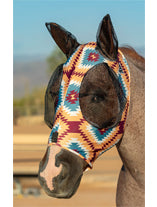How to Pick & Buy the Best Fly Mask for Your Horse
One of the first things that horse owners think of when it comes to fly control is the fly mask (after fly spray, of course). At first, picking out a fly mask for your horse seems simple enough, until you see the selection of horse fly masks on Jeffers. There are multiple styles and features that can easily be confusing if you don’t know what you are looking for.
Why Are Fly Masks Important?
Fly Masks are important for more reasons than keeping your horse comfortable. If you stop and look at where flies are drawn to on your horse's face, you will notice they congregate near the eyes and nose. Since our horses do not have hands to safely swat the flies away, they are left to rub them away which can potentially cause injury. Not to mention, this can also lead to eye infections. The fly mask acts as a protective barrier against flies that can transmit disease or for those horses that have fly bite allergies.
What Features Should I Look For?
Horse fly masks are available with or without ears covers. It is important to note that some horses require ear protection to prevent ear injuries or infection, but there are some horses that just will not tolerate something restricting their ears.
Other Popular Fly Mask Features
Extended/Detachable Nose
An extended nose is ideal for protecting your horse's sensitive nose against nuisance flies. This feature is also a lifesaver for those horses with pink noses that sunburn easily.
Shires Fly Mask with Nose Fringe
Fringe
Pro. Choice Comfort Fit Fly Mask
The addition of fringe on the nose on a fly mask/bonnet can be very beneficial. As your horse moves, so does the fringe, acting like a hand swatting the flies away.
Lycra
Horse fly masks have become increasingly popular over the last couple of years due to their ease of use. Lycra, a fabric known for its elasticity, fits a wider range of heads. Another huge benefit is that since these masks are Velcro-free, they tend to be more comfortable to wear. Most horses that won't wear a traditional mask will wear a Lycra mask.
Insecticide-Treated
Fly masks that are made from a material that has been infused with fly insecticides have shown to be a great choice for protecting your horse’s face from flies. Not only do these masks keep the flies from landing on your horse’s face, but they will also repel flies away from nearby areas, as well. You will notice that flies will not land on the nose, ears, or the throatlatch area. However, all good things must come to an end. This insecticide will eventually wash out after about a dozen washings, but it is absolutely worth the investment.
Canopy Style
Some horses show resistance to fly masks and constantly try to get them off because they cannot stand having the mesh rub on their eyes. It is important to add that some sensitive eyes cannot tolerate this rubbing. Canopy style masks are made with sewn-in stays that help to keep the masks up and off of the horse’s face even if they rub on something.
How Will I Know the Fly Mask Fits Correctly?
Just because you can get the mask on your horse’s head, doesn’t mean that it properly fits. A mask that is too small can cause rubs and a mask that is too big will have no chance of staying on your horse during turnout. A properly fitted mask should fit as follows:
- The traditional fly mask covers the horse’s eyes and jaw and usually stops halfway to the nose.
- The nose of the mask should sit about one to two fingers width below the cheekbone to help prevent rubbing. You should also adjust the Velcro closure so that you can slip a finger or two in between the mask and your horse. Any looser than this and it will make it easier for the mask to come off if your horse rubs their head.
- The throatlatch needs to fit similarly to the muzzle. Make sure that you can fit a couple of fingers in between the throat and the mask. Too snug and the mask can easily become too tight when your horse’s head is up. Too loose and the mask will easily slide over the ears.
- The last thing to check is to make sure that the mask is not too tight in the eye area. The fly mask can cause major problems if it rubs on the eyes because it can cause more irritations and eye abrasions. Make sure that this area is loose enough so that the fly mask does not touch your horse's eyes or eyelashes.
Fly Masks Work Hard So You Don't Have To
Investing in a quality fly control program will save you money in the long run. Fly masks not only prevent irritants such as bites and sunburn, but they can also protect your horse against insect-borne diseases. Paying an extra $10 to $40 to meet your horse’s needs and protect against multiple health hazards, seems like common sense. Like Benjamin Franklin said, “An ounce of prevention is worth a pound of cure.”

